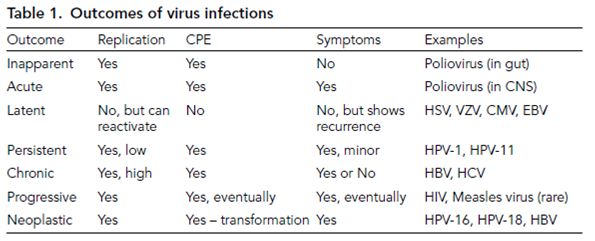Clinical outcomes of infection
The outcome of a viral infection is dependent on a number of factors including age, immune status, and physiological well-being of the host. For example, HSV infection is often fatal in the neonate but when it occurs in the older child it is not so, and also often without overt symptoms. Epstein–Barr virus (EBV) causes a very mild febrile illness in young children but the more severe infectious mononucleosis (glandular fever) in teen- agers and young adults. CMV in a healthy individual may cause a mild febrile illness, but in immunosuppressed individuals it can lead to fatal pneumonia. Measles rarely causes severe complications in healthy, well-nourished children, but is fatal in many children living in developing countries where malnutrition is a compounding problem (the WHO estimate for 2008 was 164 000 deaths). For the purposes of study and comparison, the outcome of a virus infection can be categorized (Table 1) by considering the extent of virus synthesis, cellular damage, and clinical symptoms. It will become clear from Table 1, and the descriptions below, that some viruses can give rise to more than one type of infectious outcome, depending on the clinical situation. Before we describe viral patho- genic outcomes, it is important to remember that many infections are abortive. Entry into nonsusceptible hosts (that lack suitable cells and/or cell receptors), or attachment (and even penetration) of virus to nonsusceptible cells in such a host will not result in replication and the process of invasion is a dead end.
